A Bionic Goal-Oriented Path Planning Method Based on an Experience Map
Abstract
1. Introduction
- 1.
- A bionic goal-oriented global path planning framework has been developed to address the challenge of rapid global path planning in complex environments;
- 2.
- An experience map-based successor representation model is constructed, and it is integrated with reinforcement learning to create the predictive map, addressing the challenge of long-term reward prediction. This approach facilitates the rapid planning of the experience sequence towards the navigation goal;
- 3.
- Compared to the traditional path planning method, the proposed method demonstrates enhanced adaptability to environmental changes, and plans the optimal path with high efficiency.
2. System Overview
3. Global Path Planning
- The first strategy involves using learned environmental representations to simulate potential state sequences for reward prediction. However, this strategy presents significant computational challenges in real-world environments due to the exponential growth of possible future states.
- The second strategy relies on trial-and-error learning to approximate a value function that predicts future rewards based on current states. However, this approach struggles in dynamic environments, where evolving reward contingencies require continuous re-optimization of value estimates.
- The third strategy utilizes a successor representation framework that encodes states based on their predicted future state distributions. This representation allows for efficient long-term reward estimation while remaining computationally tractable and neurobiologically plausible, aligning closely with empirical observations of hippocampal function.
3.1. Predictive Map Construction
3.2. Convergence Rule of SR Model
3.3. Goal-Oriented Path Planning
4. Experimental Results
4.1. Results Based on SynPerData
4.2. Results Based on QUTCarparkData
4.3. Results in Maze Environment
5. Conclusions
6. Discussion
- Environmental complexity: Our method may face challenges in highly unpredictable or rapidly changing environments, such as home service and factory surveillance scenarios. Future research could investigate adaptive mechanisms to enhance the robustness performance under such conditions.
- Parameter sensitivity: The effectiveness of our method can be influenced by specific parameter choices. We have included a preliminary sensitivity analysis to highlight how variations in key parameters affect performance, and we suggest that further analysis could provide deeper insights.
- Scalability: Although the current implementation performs well in simulated scenarios, scalability to larger and more complex environments remains an area for future exploration.
- System biological plausibility: More advanced biological inspiration mechanisms could enable more intelligent and autonomous navigation for mobile robots.
Author Contributions
Funding
Institutional Review Board Statement
Informed Consent Statement
Data Availability Statement
Conflicts of Interest
References
- Alhmiedat, T.; Marei, A.M.; Messoudi, W.; Albelwi, S.; Bushnag, A.; Bassfar, Z.; Alnajjar, F.; Elfaki, A.O. A SLAM-based localization and navigation system for social robots: The Pepper robot case. Machines 2023, 11, 158. [Google Scholar] [CrossRef]
- Alqobali, R.; Alshmrani, M.; Alnasser, R.; Rashidi, A.; Alhmiedat, T.; Alia, O.M.D. A survey on robot semantic navigation systems for indoor environments. Appl. Sci. 2024, 14, 89. [Google Scholar] [CrossRef]
- Yasuda, Y.D.V.; Martins, L.E.G.; Cappabianco, F.A.M. Autonomous visual navigation for mobile robots: A systematic literature review. ACM Comput. Surv. 2020, 53, 1–34. [Google Scholar] [CrossRef]
- Richter, M.; Sandamirskaya, Y.; Schoner, G. A robotic architecture for action selection and behavioral organization inspired by human cognition. In Proceedings of the IEEE/RSJ International Conference on Intelligent Robots and Systems, Vilamoura-Algarve, Portugal, 7–12 October 2012. [Google Scholar]
- Niloy, M.A.; Shama, A.; Chakrabortty, R.K.; Ryan, M.J.; Badal, F.R.; Tasneem, Z. Critical design and control issues of indoor autonomous mobile robots: A review. IEEE Access 2021, 9, 35338–35370. [Google Scholar] [CrossRef]
- Barry, C.; Burgess, N. Neural mechanisms of self-location. Curr. Biol. 2014, 24, R330–R339. [Google Scholar] [CrossRef]
- Zhou, W.; Fan, C.; He, X.; Hu, X.; Fan, Y.; Wu, X.; Shang, H. Integrated bionic polarized vision/vins for goal-directed navigation and homing in unmanned ground vehicle. IEEE Sens. J. 2021, 21, 11232–11241. [Google Scholar] [CrossRef]
- Wagatsuma, H.; Yamaguchi, Y. Neural dynamics of the cognitive map in the hippocampus. Cogn. Neurodyn. 2007, 1, 119–141. [Google Scholar] [CrossRef]
- Barry, C.; Hayman, R.; Burgess, N.; Jeffery, K.J. Experience-dependent rescaling of entorhinal grids. Nat. Neurosci. 2007, 10, 682–684. [Google Scholar] [CrossRef]
- Larry, R.S. Memory systems of the brain: A brief history and current perspective. Neurobiol. Learn. Mem. 2004, 82, 171–177. [Google Scholar]
- Lisman, J.; Buzsáki, G.; Eichenbaum, H.; Nadel, L.; Ranganath, C.; Redish, A.D. Viewpoints: How the hippocampus contributes to memory, navigation and cognition. Nat. Neurosci. 2017, 20, 1434–1447. [Google Scholar] [CrossRef]
- Stachenfeld, K.L.; Botvinick, M.M.; Gershman, S.J. Design principles of the hippocampal cognitive map. In Proceedings of the Annual Conference on Neural Information Processing Systems, Quebec, QC, Canada, 8–13 December 2014. [Google Scholar]
- Pfeifer, B.E.; Fostr, D.J. Hippocampal place-cell sequences depict future paths to remembered goals. Nature 2013, 497, 74–79. [Google Scholar] [CrossRef] [PubMed]
- Buzsáki, G.; Moser, E. Memory, navigation and theta rhythm in the hippocampal-entorhinal system. Nat. Neurosci. 2013, 16, 130–138. [Google Scholar] [CrossRef] [PubMed]
- Bicanski, A.; Burgess, N. Neuronal vector coding in spatial cognition. Nat. Rev. Neurosci. 2020, 21, 453–470. [Google Scholar] [CrossRef]
- Milford, M.; Wyeth, G. Mapping a suburb with a single camera using a biologically inspired SLAM system. IEEE Trans. Robot. 2008, 24, 1038–1053. [Google Scholar] [CrossRef]
- Ball, D.; Heath, S.; Wiles, J.; Wyeth, G.; Corke, P.; Milford, M. OpenRatSLAM: An open source brain-based SLAM system. Auton. Robot. 2013, 34, 149–176. [Google Scholar] [CrossRef]
- Yu, F.; Shang, J.; Hu, Y.; Milford, M. NeuroSLAM: A brain-inspired SLAM system for 3D environments. Biol. Cybern. 2019, 113, 515–545. [Google Scholar] [CrossRef]
- Tejera, G.; Llofriu, M.; Barrera, A.; Weitzenfeld, A. Bio-inspired robotics: A spatial cognition model integrating place cells, grid cells and head direction cells. J. Intell. Robot. Syst. 2018, 91, 85–99. [Google Scholar] [CrossRef]
- Milford, M.; Wyeth, G. Persistent navigation and mapping using a biologically inspired SLAM system. Int. J. Robot. Res. 2010, 29, 1131–1153. [Google Scholar] [CrossRef]
- Stachowicz, D.; Kruijff, G.M. Episodic-like memory for cognitive robots. IEEE Trans. Auton. Ment. Develop. 2011, 4, 1–16. [Google Scholar] [CrossRef]
- Naghizadeh, A.; Berenjian, S.; Margolis, D.J. GNM: Grid cell navigation model. Expert Syst. Appl. 2020, 148, 113217. [Google Scholar] [CrossRef]
- Zou, Q.; Cong, M.; Liu, D.; Du, Y. A neurobiologically inspired mapping and navigating framework for mobile robots. Neurocomputing 2021, 460, 181–194. [Google Scholar] [CrossRef]
- Zou, Q.; Wu, C.; Cong, M.; Liu, D. Brain Cognition Mechanism-Inspired Hierarchical Navigation Method for Mobile Robots. J. Bionic Eng. 2024, 21, 852–865. [Google Scholar] [CrossRef]
- Banino, A.; Barry, C.; Uria, B.; Blundell, C.; Lillicrap, T.; Mirowski, P. Vector-based navigation using grid-like representations in artificial agents. Nature 2018, 557, 429–433. [Google Scholar] [CrossRef] [PubMed]
- Scleidorovich, P.; Llofriu, M.; Fellous, J.M.; Weitzenfeld, A. A computational model for spatial cognition combining dorsal and ventral hippocampal place field maps: Multiscale navigation. Biol. Cybern. 2020, 114, 187–207. [Google Scholar] [CrossRef]
- Llofriu, M.; Scleidorovich, P.; Tejera, G.; Contreras, M.; Pelc, T.; Fellous, J.M.; Weitzenfeld, A. A computational model for a multi-goal spatial navigation task inspired by rodent studies. In Proceedings of the International Joint Conference on Neural Networks, Budapest, Hungary, 14–19 July 2019. [Google Scholar]
- Yu, N.; Li, C.; Fang, L. Target-oriented bionic navigation model based on direct reinforcement learning. Sci. Sin. Inform. 2016, 46, 325–337. [Google Scholar]
- Yuan, J.; Guo, W.; Hou, Z.; Zha, F.; Li, M.; Sun, L.; Wang, P. Robot navigation strategy in complex environment based on episode cognition. J. Bionic Eng. 2023, 20, 1–15. [Google Scholar] [CrossRef]
- Yu, S.; Xu, H.; Wu, C.; Jiang, X.; Sun, R.; Sun, L. Bionic path planning fusing episodic memory based on RatSLAM. Biomimetics 2023, 8, 59. [Google Scholar] [CrossRef]
- Stachenfeld, K.L.; Botvinick, M.M.; Gershman, S.J. The hippocampus as a predictive map. Nat. Neurosci. 2017, 20, 1643–1653. [Google Scholar] [CrossRef]
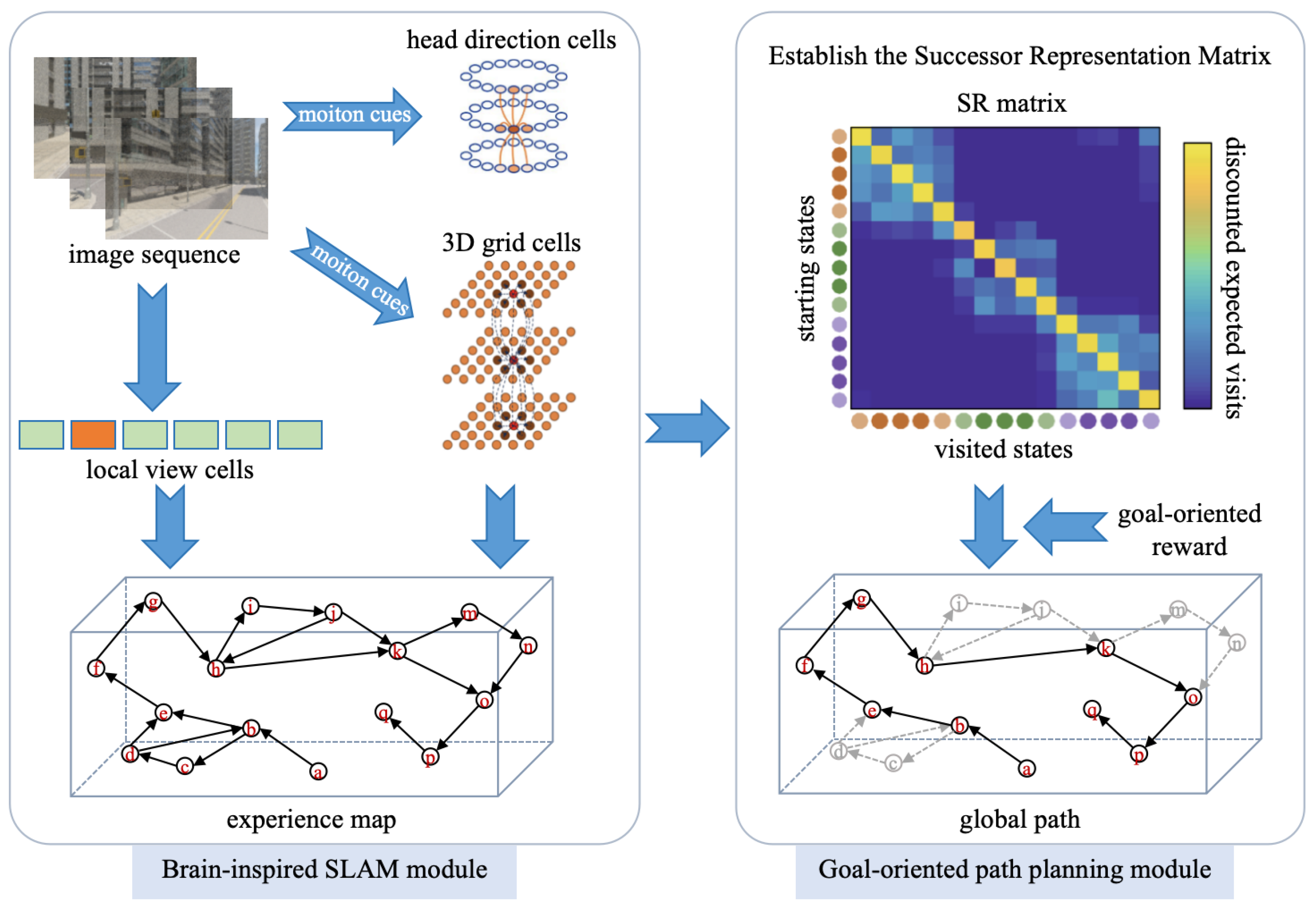

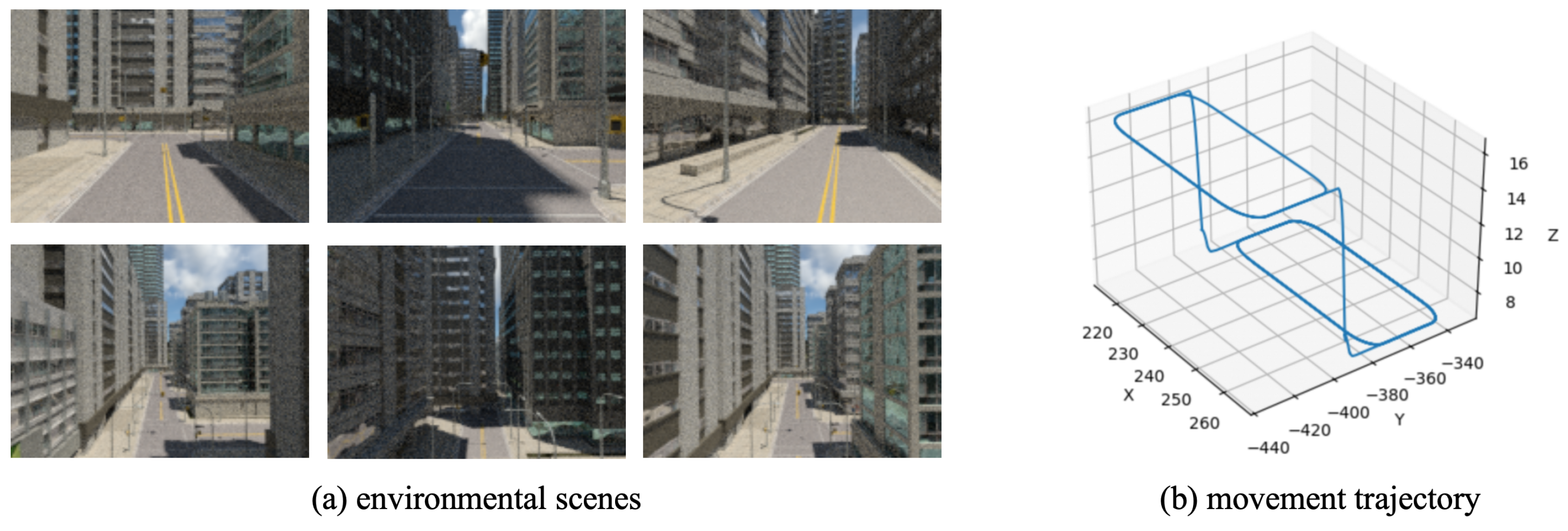

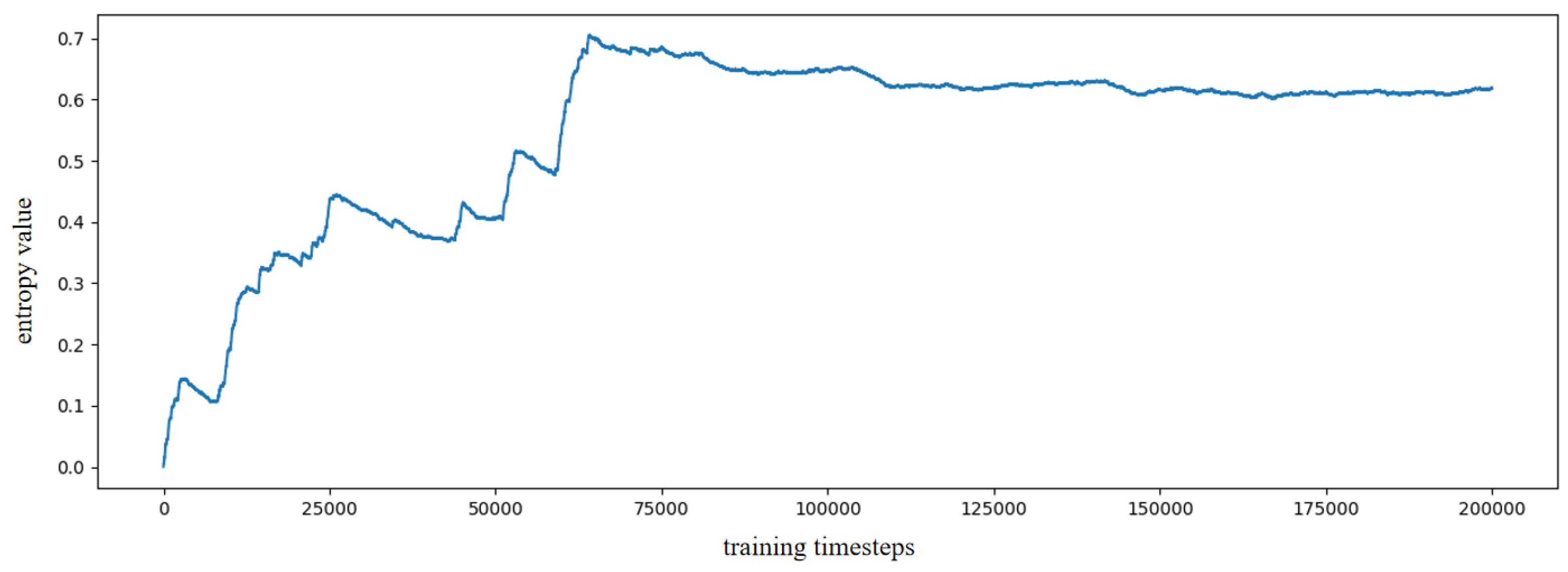
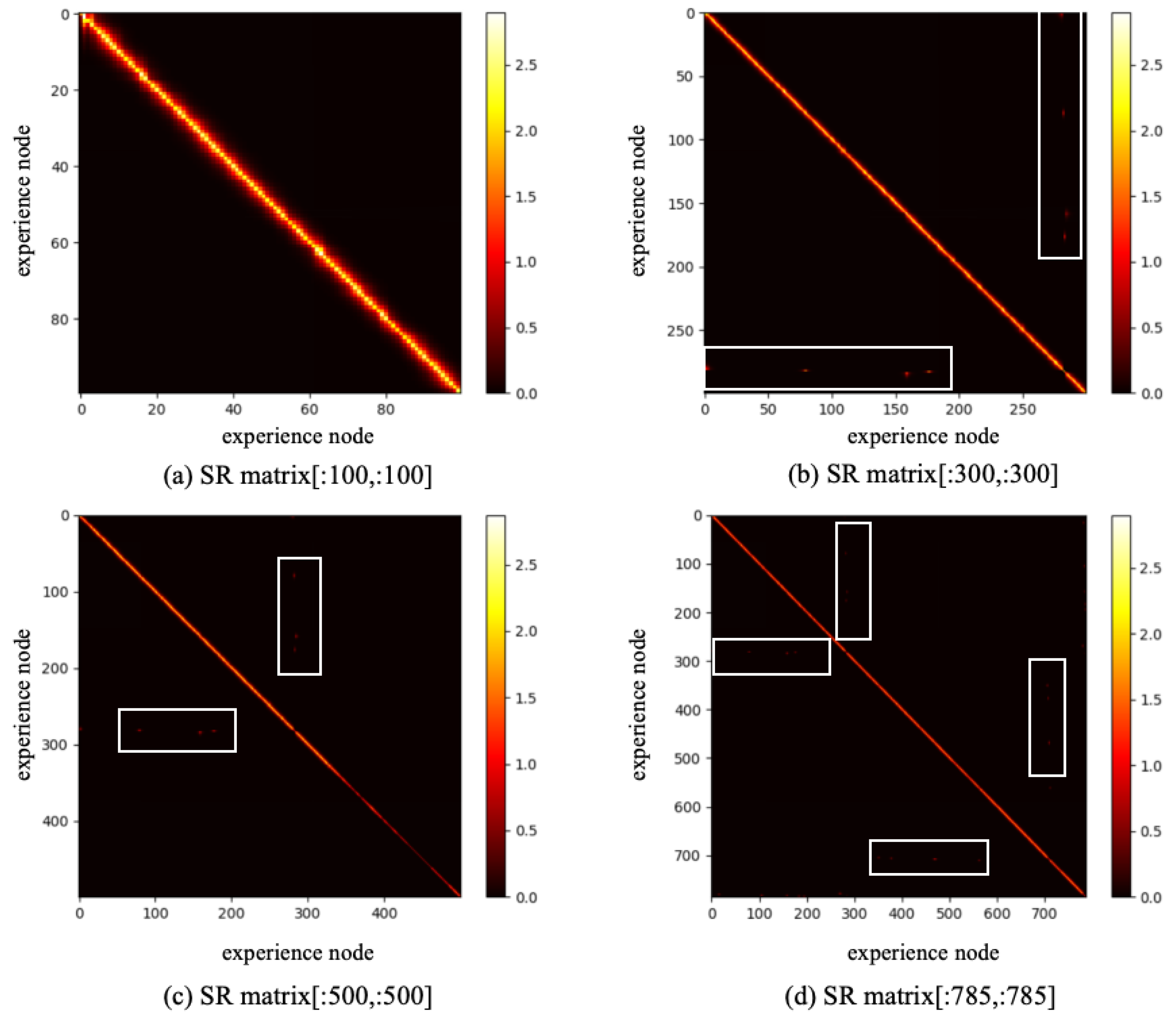
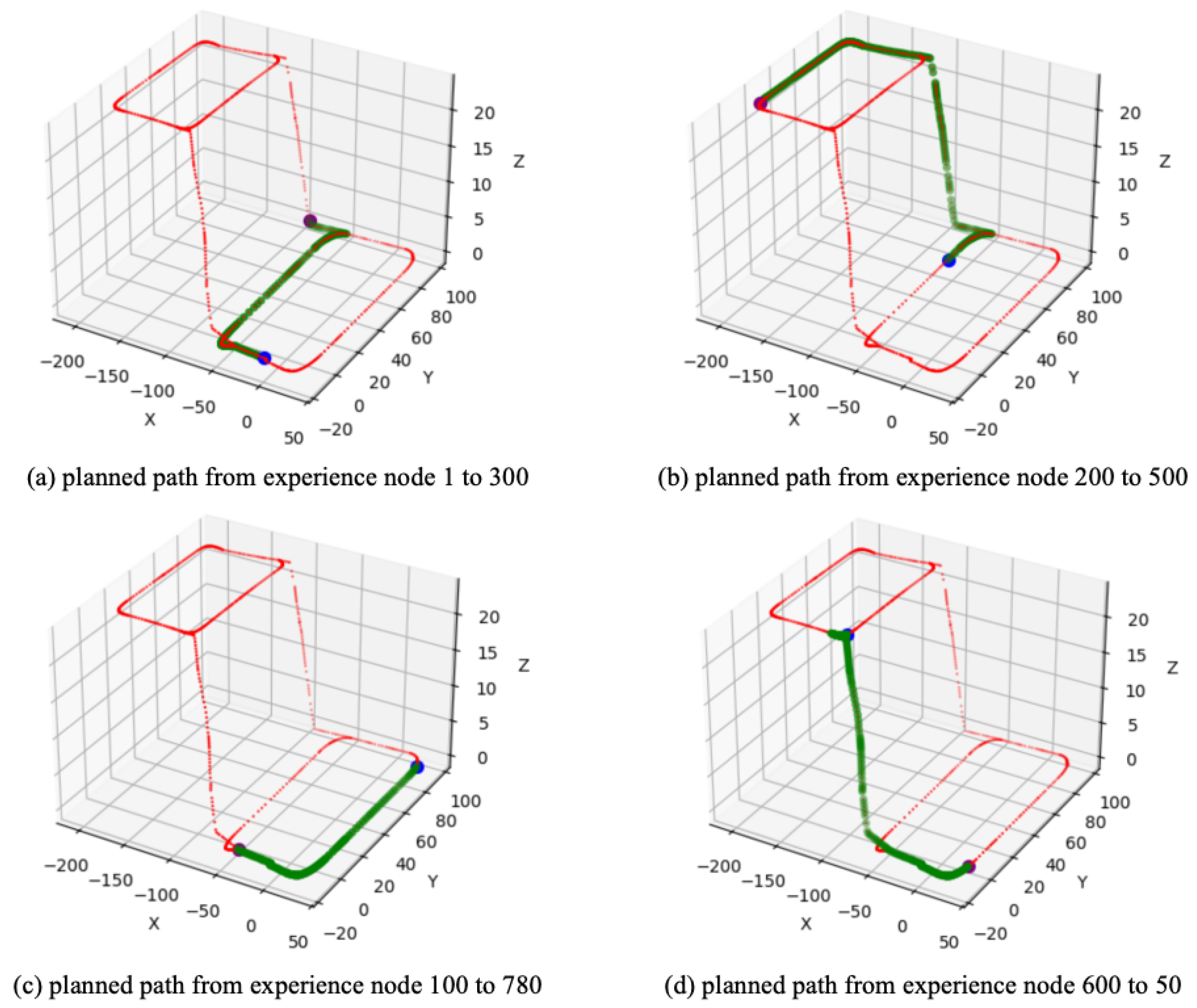


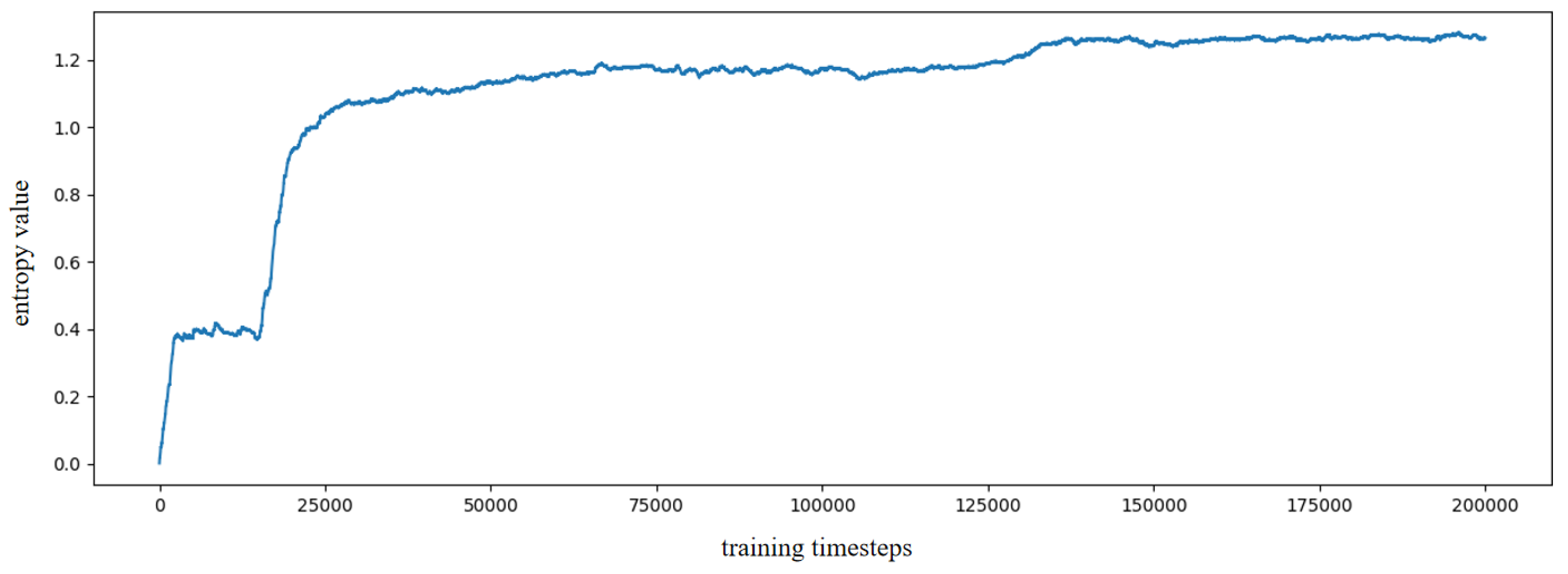

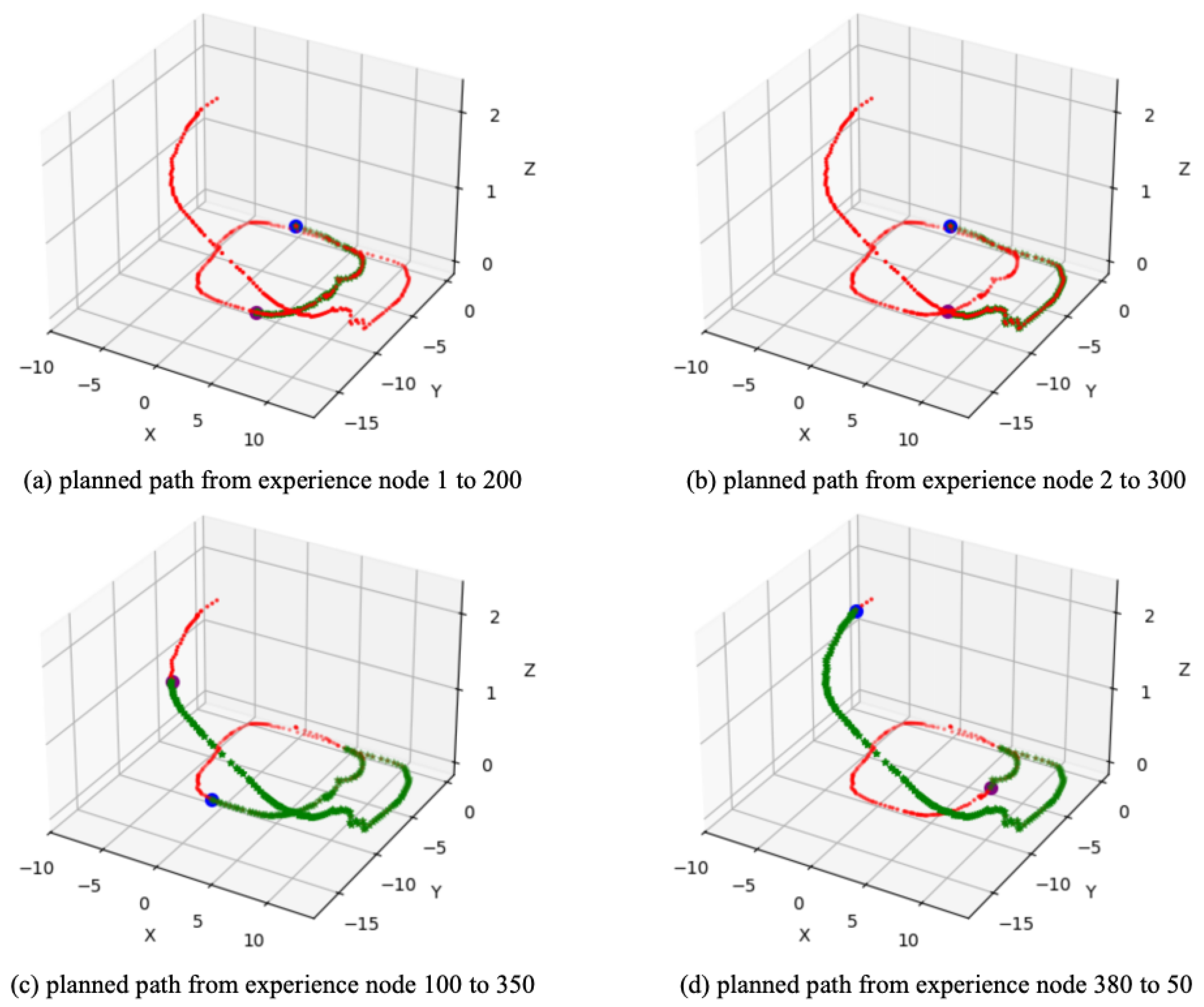
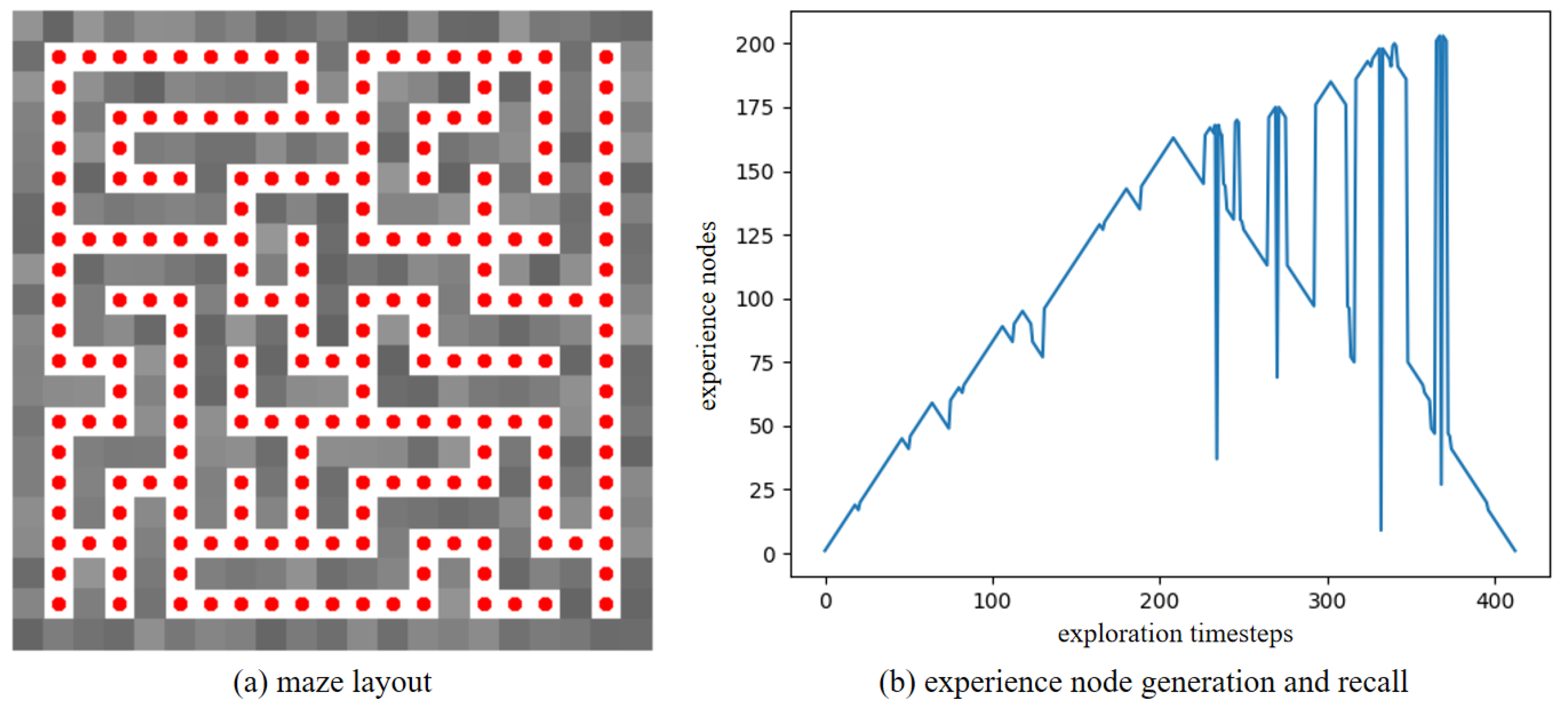
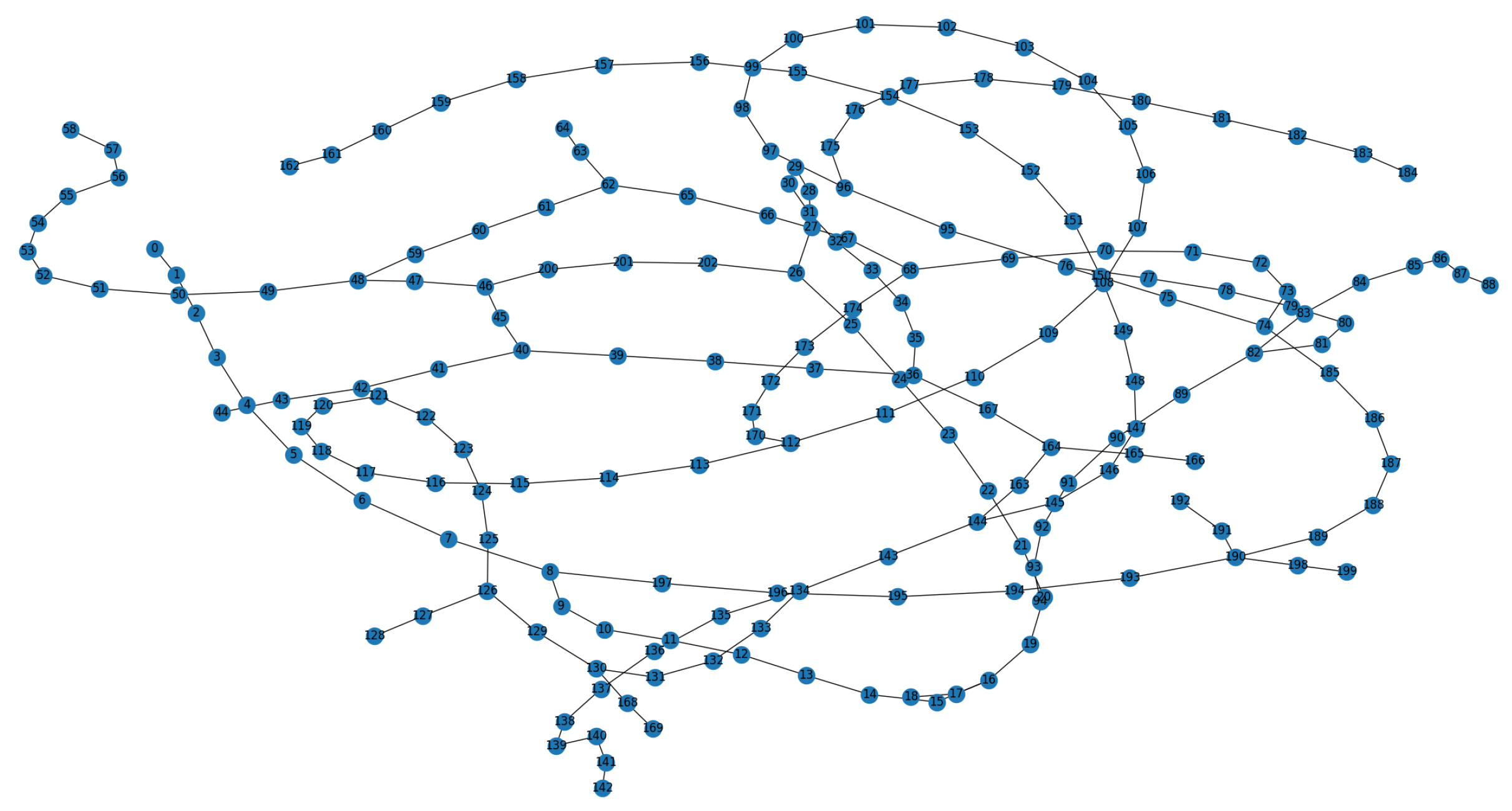
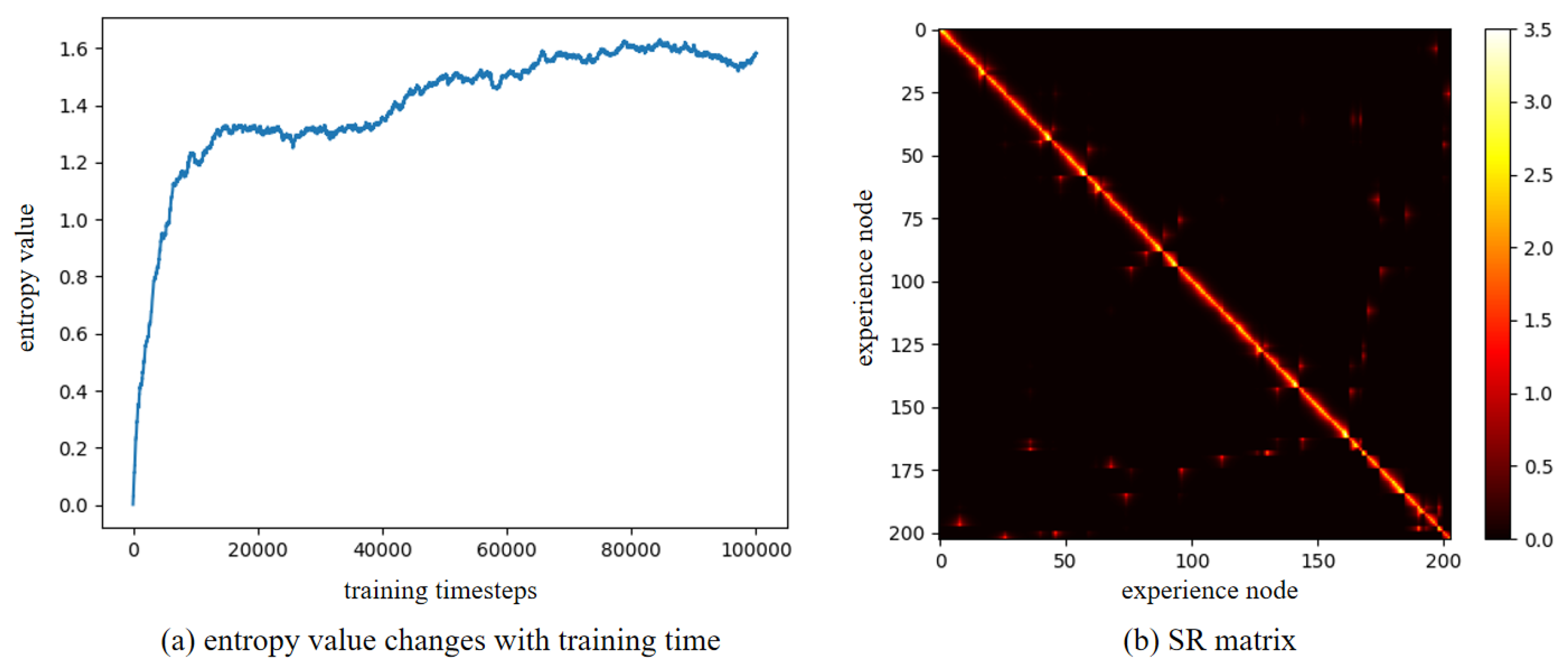
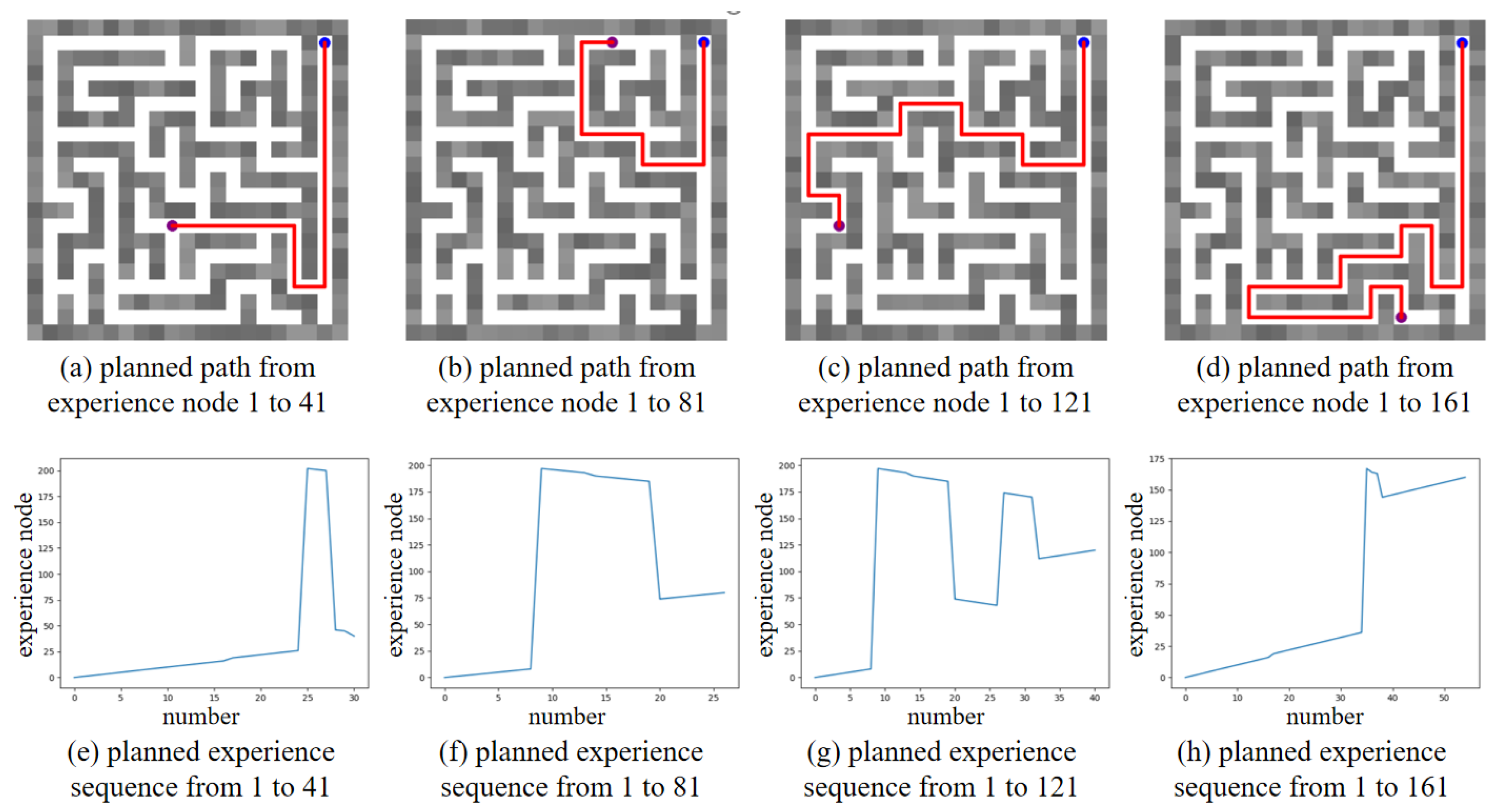

| Reinforcement Learning-Based SR Matrix Building Algorithm |
|---|
| Input: Experience map |
| Output: SR matrix |
| (1) Obtain the robotic state nodes according to the constructed experience map |
| (2) Obtain the adjacent selectable state nodes for each state node |
| (3) Initialize the robot’s current state as the initial state, initialize the training parameters of SR model |
| (4) Set the policy as a random policy, and initialize the SR matrix as an identity matrix |
| (5) Obtain the adjacent nodes of the robot’s current node, and set the connection probabilities of these nodes to the current node to be the same |
| (6) For all state node in the experience map, calculate and update for each state’s adjacent nodes, as well as update the connection probability |
| (7) Obtain the updated SR matrix and convergence information entropy |
| (8) Determine whether the model is converged: if no, go to (6); if yes, output the SR matrix |
| (9) Obtain the trained SR matrix for the experience map |
| Method | Experience (a) | Experience (b) | Experience (c) | Experience (d) |
|---|---|---|---|---|
| Dijkstra | 1.106 | 1.411 | 0.932 | 1.117 |
| Ours | 0.289 | 0.472 | 0.226 | 0.770 |
| Method | Experience (a) | Experience (b) | Experience (c) | Experience (d) |
|---|---|---|---|---|
| Dijkstra | 0.267 | 0.310 | 0.395 | 0.311 |
| Ours | 0.118 | 0.120 | 0.240 | 0.212 |
| Method | Experience (a) | Experience (b) | Experience (c) | Experience (d) |
|---|---|---|---|---|
| Dijkstra | 0.115 | 0.164 | 0.218 | 0.216 |
| Ours | 0.061 | 0.075 | 0.105 | 0.108 |
Disclaimer/Publisher’s Note: The statements, opinions and data contained in all publications are solely those of the individual author(s) and contributor(s) and not of MDPI and/or the editor(s). MDPI and/or the editor(s) disclaim responsibility for any injury to people or property resulting from any ideas, methods, instructions or products referred to in the content. |
© 2025 by the authors. Licensee MDPI, Basel, Switzerland. This article is an open access article distributed under the terms and conditions of the Creative Commons Attribution (CC BY) license (https://creativecommons.org/licenses/by/4.0/).
Share and Cite
Zou, Q.; Chen, Y. A Bionic Goal-Oriented Path Planning Method Based on an Experience Map. Biomimetics 2025, 10, 305. https://doi.org/10.3390/biomimetics10050305
Zou Q, Chen Y. A Bionic Goal-Oriented Path Planning Method Based on an Experience Map. Biomimetics. 2025; 10(5):305. https://doi.org/10.3390/biomimetics10050305
Chicago/Turabian StyleZou, Qiang, and Yiwei Chen. 2025. "A Bionic Goal-Oriented Path Planning Method Based on an Experience Map" Biomimetics 10, no. 5: 305. https://doi.org/10.3390/biomimetics10050305
APA StyleZou, Q., & Chen, Y. (2025). A Bionic Goal-Oriented Path Planning Method Based on an Experience Map. Biomimetics, 10(5), 305. https://doi.org/10.3390/biomimetics10050305







